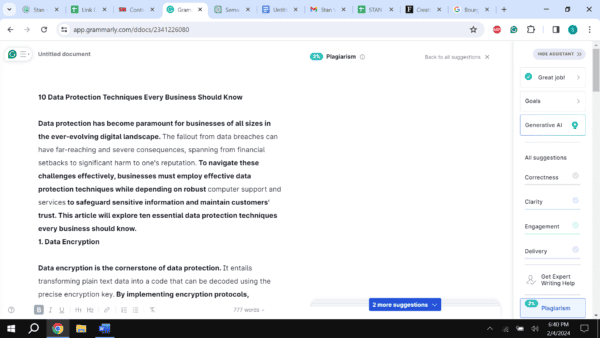Data protection has become paramount for businesses of all sizes in the ever-evolving digital landscape. The fallout from data breaches can have far-reaching and severe consequences, spanning from financial setbacks to significant harm to one’s reputation. To navigate these challenges effectively, businesses must employ effective data protection techniques while depending on robust computer support and services to safeguard sensitive information and maintain customers’ trust. This article will explore ten essential data protection techniques every business should know.
1. Data Encryption
Data encryption is the cornerstone of data protection. It entails transforming plain text data into a code that can be decoded using the precise encryption key. By implementing encryption protocols, businesses can ensure that even if unauthorized individuals access their data, it remains unintelligible. This technique is vital for securing sensitive customer information and confidential business data.
2. Regular Data Backups
Data loss can manifest due to myriad factors, encompassing hardware failures, cyberattacks, or inadvertent human errors. To diminish the ramifications of these occurrences, businesses must conduct routine data backups. This process entails duplicating crucial data and securing its storage in an offsite location. Data management solutions like Hevo Data can assist businesses in efficiently managing and backing up their data, ensuring seamless recovery in case of data loss. In the event of data loss, these backup copies stand ready to reinstate vital information seamlessly.
3. Access Control Policies
Implementing strict access control policies stands as another crucial data protection technique. In this regard, businesses should meticulously define who can access specific data and delineate the circumstances under which such access is permissible. By imposing rigorous restrictions on data access and exclusively permitting entry to authorized personnel, organizations can effectively mitigate the potential for data breaches and leaks, thus enhancing the overall security posture of their information assets.
4. Employee Training
One of the weakest links in data protection is often the employees themselves. Human error can lead to security breaches, unintentional data leaks, and phishing attacks. Therefore, businesses must provide all employees with comprehensive training on data security practices. This entails the ability to identify and steer clear of phishing attempts while adhering to secure password management practices.
5. Multi-Factor Authentication (MFA)
Multi-factor authentication enhances security by demanding users to furnish multiple forms of identification before gaining access to sensitive data or systems. Multi-factor authentication enhances security by requiring users to provide various forms of identification before gaining access to sensitive data or systems. This technique significantly reduces the risk of unauthorized access, even if a password is compromised.
6. Intrusion Detection Systems (IDS)
Intrusion detection systems have been developed to oversee network traffic and identify atypical or questionable behaviors. When such activities are identified, the system can trigger alerts or take actions to mitigate the threat. IDS helps in early detection of potential security breaches, allowing businesses to respond promptly.
7. Regular Software Updates
Cybercriminals can exploit software vulnerabilities to access a business’s systems. To counter this, businesses should regularly update their operating systems and software applications. These updates often include patches that fix known vulnerabilities, enhancing overall security.
8. Network Segmentation
Network segmentation is a strategic approach that entails partitioning a company’s network infrastructure into smaller, isolated segments. Doing so is a formidable barrier against attackers’ lateral movement within the network and effectively restricts their access to sensitive data. This segmentation architecture proves invaluable in safeguarding a company’s digital assets. If one segment is compromised, the remaining segments remain resiliently protected, fortifying the organization’s defenses and creating a formidable obstacle for hackers attempting to breach critical information. This proactive security measure is essential to modern cybersecurity practices, enhancing a company’s overall resilience in the face of evolving threats.
9. Incident Response Plan
A clearly outlined incident response strategy is crucial for efficiently managing data breaches or security incidents. This plan should outline the steps during a breach, including containment, investigation, notification of affected parties, and recovery strategies. Careful and well-structured preparation in response to a security breach can hold the potential to mitigate the negative consequences effectively.
10. Data Privacy Compliance
Businesses must strictly adhere to the pertinent data privacy regulations and laws within their respective industries and geographic locations. Non-compliance with established regulations such as GDPR or HIPAA is not discretionary; rather, it carries the potential for imposing substantial penalties and consequences. To ensure compliance, businesses should regularly assess their data handling practices and make necessary adjustments.

Conclusion
Data protection is a critical aspect of modern business operations. Employing these ten data protection techniques while leveraging reliable computer support and services can significantly enhance a company’s ability to safeguard its sensitive information, maintain customers’ trust, and minimize the risks associated with data breaches. With the ever-evolving threat landscape, businesses must remain vigilant and proactive in their approach to data security.
 Gearfuse Technology, Science, Culture & More
Gearfuse Technology, Science, Culture & More


